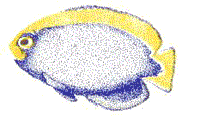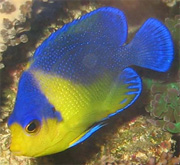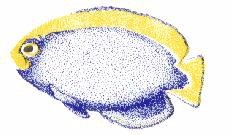|
THE ECHINODERMS,
AN INTRODUCTION
By. Jim Wolf C.S.U.N. Marine Biologist
The echinoderms are perhaps the most familiar of the marine organisms
you will find in a tropical fish store. Almost everyone is familiar with
starfish. This phylum of animals is exclusively marine, and boasts more
than 7,000 living species with 13,000 fossil species. There are 5 major
types of echinoderms, and despite their different appearances, they are
all variations on a similar body plan.
Starfish show the marked five-part symmetry that is the trademark of
the phylum. The other groups still have this five part symmetry, but it
has become more difficult to discern. In addition to their five part symmetry,
echinoderms have the following features in common: almost all are benthic
(live on the substrate), they are of one sex, have tube feet, a complete
digestive tract, a simple nervous system, a water driven hydraulic system,
and a conspicuous cuticle. This cuticle appears as spiny protuberances
through the skin of the animal, and gives them their name; Echinodermata,
which means spiny skinned in Greek.
The five classes of Echinodermata each are distinctly modified to exploit
the environment in which they live. The starfish are slow moving predators
that use their tube feet to catch and pry open prey items, and they belong
to the class Asteroidea.
The class Ophioroidea includes the basket stars and brittle stars. These
animals have lost their tube feet, and are sleeker and quicker moving predators
as with the brittle stars, or slow moving filter feeding basket stars.
The sea urchins and sand dollars belong to the class Ecinoidea. Their
ossicles are fused into a solid sphere called a test, and some of their
tube feet are modified into spines. Most of these animals eat algae or
detritus (dead decaying matter) using a special group of modified "teeth".
The sea cucumbers are perhaps the most modified of the Echinoderms.
They have greatly reduced ossicles, and consequently look like small sausages.
Most are bottom feeders, sopping up microscopic particles with a special
set of tube feet that are modified into a crown of feeding tentacles.
The last group is the Crinodea or sea lilies. These are the most primitive
of the echinoderms. Many forms live attached to the substrate by a stalk,
and filter food from the water using their many highly branched upturned
arms. To help you visualized the similarity in the body plans of these
organisms, try imagining the following scenario. Take a starfish, and fold
its five arms up towards a point. This now resembles a sphere, much like
a sea urchin. Take the sphere and elongate it, and it starts to resemble
a sea cucumber. Take that earlier starfish, and make its arms skinny and
mobile, or highly branched, and you now have brittle stars, and basket
stars. If you turn a starfish upside down, and give it many highly branched
arms, it resembles a sea lily.
|











